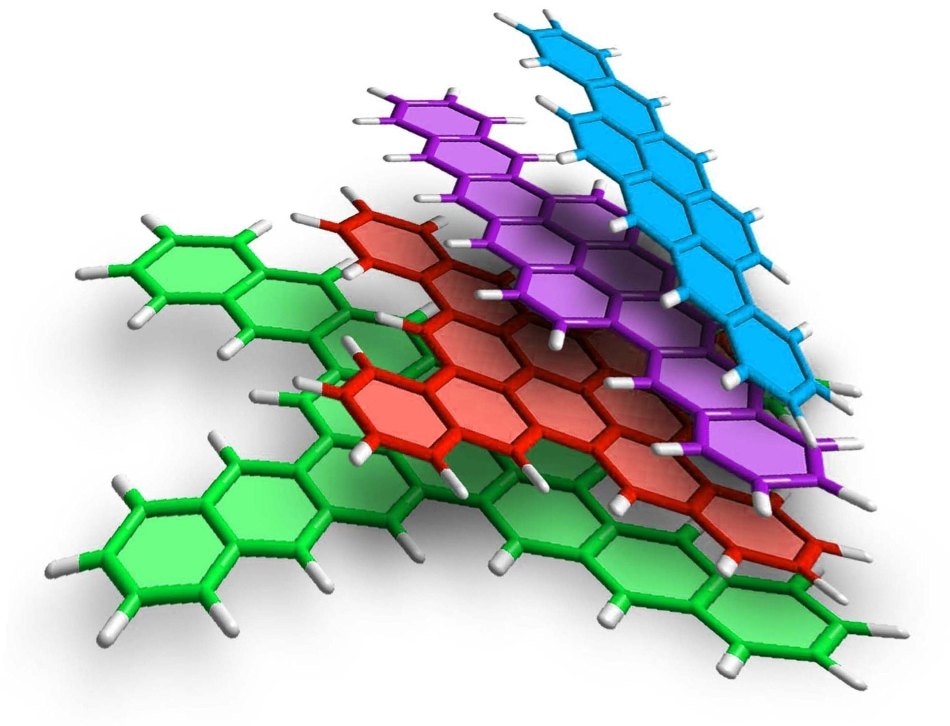Jan 30 2019
Graphene is a favorable material for application in nanoelectronics. But its electronic properties rely significantly on how the edges of the carbon layer are developed. Zigzag patterns are especially fascinating in this respect, but thus far, it has been nearly impossible to produce edges with a pattern like this.
 The much sought-after zigzag pattern can be found either in staggered rows of honeycombs (blue and purple) or four-limbed stars surrounding a central point of four graphene honeycombs (red and green). (Image credit: FAU/Konstantin Amsharov)
The much sought-after zigzag pattern can be found either in staggered rows of honeycombs (blue and purple) or four-limbed stars surrounding a central point of four graphene honeycombs (red and green). (Image credit: FAU/Konstantin Amsharov)
Presently, physicists and chemists at FAU have been successful in creating stable nanographene having a zigzag edge. Besides that, the technique they used was even relatively simple. Their study, carried out within the framework of collaborative research Centre 953—Synthetic Carbon Allotropes supported by the German Research Foundation (DFG), has currently been published in the journal Nature Communications.
Cove, bay, armchair, fjord, and zigzag—when chemists use terms such as these, it is obvious that they are denoting nanographene, more precisely, the shape adopted by the edges of nanographene, that is, small fragments of graphene. Graphene is made up of a single-layered carbon structure in which each carbon atom is enclosed by three others. This forms a pattern indicative of a honeycomb, with atoms positioned in the corners. Nanographene is a potential material for use in microelectronics, substituting silicon which is currently in use and taking microelectronics down to the nanoscale.
The material’s electronic properties depend a lot on its size, shape, and above all, periphery, in other words, how the edges are organized. A zigzag periphery is especially suitable, as in this case, the electrons acting as charge carriers are more mobile than in other edge structures. This means that using pieces of zigzag-shaped graphene in nanoelectronic parts may enable higher frequencies for switches.
The problem presently in front of materials scientists, who are keen to research only zigzag nanographene, is that this form makes the compounds quite unstable, and incapable of being made in a controlled manner. However, this is a criterion if the electronic properties are to be examined in detail.
The research team led by PD Dr Konstantin Amsharov from the Chair of Organic Chemistry II has currently been successful in achieving just that. They have discovered not only a direct technique for synthesizing zigzag nanographene but also the procedure to deliver a yield of close to 100%, which is ideal for large-scale production. They have already created a technically significant quantity in the lab.
Firstly, the FAU scientists create preliminary molecules, which they then fit together in a honeycomb structure over numerous cycles, in a process called cyclization. Finally, graphene fragments are made from staggered rows of honeycombs or four-limbed stars surrounding a core point of four graphene honeycombs, with the coveted zigzag pattern to their edges. Why is this technique capable of creating stable zigzag nanographene? The reason can be found in the fact that the product can crystallize directly even during synthesis. In their solid state, the molecules are not exposed to oxygen. In solution, however, oxidation makes the structures to crumble rapidly.
This method allows researchers to create large graphene pieces while keeping control over their periphery and shape. This innovation in graphene research means that researchers will soon be able to create and study a range of fascinating nanographene structures, a key step toward applying the material in nanoelectronic components.